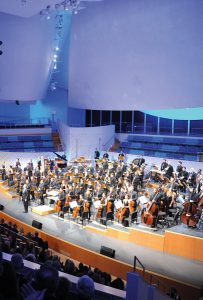
By Márcio Bezerra
If Thomas Mann thought that Wagner’s art was “dilettantism raised to the level of genius,” what would he have made of Gustav Mahler’s symphonic output?
Mahler, one of the more important conductors of the late 19th and early 20th centuries (in both Europe and New York City), had a limited compositional output as he wrote his symphonies mostly during his summer vacations. They were highly personal experiments that closely reflected his personal life and his metaphysical musings.
Most of his nine symphonies were received rather negatively by perplexed audiences at the time, and had only a restricted geographical performance history. It was not until they were championed by Leonard Bernstein (among other American musicians) that they became part of the symphonic canon and more widely accepted as great works of music.
Their demand for experienced directors — thanks to their kaleidoscopic mood swings — their expanded instrumentations and their technical difficulties make performances in our area rare.
Therefore, it was disappointing to see Dreyfoos Hall with many empty seats for the New World Symphony’s performance of his Symphony No. 6 (in A minor) as part of the Classical Concerts Series at the Kravis Center on Dec. 11.
Directed by guest conductor Andrew Grams, the young ensemble based in Miami Beach did an overall fine job that surely deserved a full house and much more than the usual “walking-standing ovation” at the end. Yes, the audience may have changed a bit, but the bad habits remain.

From the start, one could distinguish the high quality of the orchestra’s individual performers, especially brass players, in this case. Unfortunately, there were not enough string players to counterbalance the massive brass and percussion sections.
That imbalance was particularly problematic in the first movement: Important melodic material by the violins just drowned under the massive brass lines. Director Grams tried to compensate by favoring a straightforward handling of tempo, smoothing, sometimes too forcefully, the disparate moods that make up the work’s opening.
Fortunately, balance was less of a problem in the following three movements. The Scherzo was delivered with biting accuracy and the Andante moderato flowed smoothly.
Despite all the popularity of Mahler’s Adagietto (from his Fifth Symphony), the slow movement of the Sixth is as sublime, and more varied.
Here, the New World Symphony strings and woodwinds were the highlight, bringing up the many solos with accuracy, beautiful tone, and expressivity.
The finale was performed with brilliance and balance, notwithstanding the less-than-enough violins. The expanded percussion section played with precision and flair and the three hammer blows of fate were delivered (by an unnamed player) with dramatic seriousness.
All in all, a performance to be cherished and one that will not be repeated soon enough.